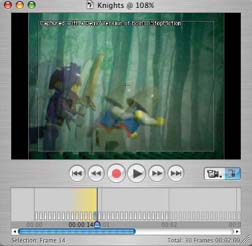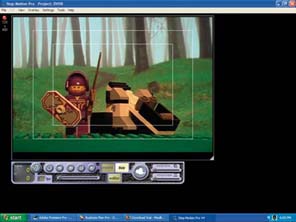Hack 91. Create a Movie Using LEGOs
| < Day Day Up > |
|
Using stop-motion software and LEGOs, you can create a movie on a very low budget. Stop-motion movies involve taking inanimate objects, such as clay models, and patiently taking a picture, moving the model slightly, taking another picture, and so on until a complete movie has been produced. "Gumby and Pokey," "Wallace and Gromit," and "Celebrity Deathmatch" are examples of productions created using claymation. Well, those of us who are artistically challenged refuse to be left out of the fun. We can make stop motion movies too, only we'll use plastic bricks instead of clay. Enter my favorite childhood toy… LEGOs.
8.3.1. Gathering Your ToolsYou should probably determine the genre of movie you would like to produce, since a cowboy will appear slightly out of place in a Science Fiction movie (unless of course, you've decided to make a SciFi Western). If you already have some LEGOs available, you might as well take them into consideration when deciding your genre.
Depending on your ambition and your budget, you should create a storyboard [Hack #6] to both clarify what you are going to be shooting and help you gather the necessary pieces for your production. You will also need a digital video camera, some stop-motion software, and a good location where you can produce your movie. Creating a stop-motion movie can be time-consuming, so finding a location that will not be physically disturbed is preferable. Although stop-motion software is not essential, it is extremely helpful in producing this type of movie. Stop-motion software is commercially available for both Macintosh and Windows. For Mac OS X, Boinx software distributes iStopMotion. For Windows, Stop Motion Pro is available from, well, Stop Motion Pro.
8.3.2. Creating Your EnvironmentThe location you choose to produce your movie can make the difference between success and failure. If your friends, family, and even pets are going to be wandering through while you are trying to shoot, your lighting will probably fluctuate and it is quite possible for your entire scene to be destroyed. Just imagine Fluffy, your beloved cat, executing a sneak attack on your lead actor and carrying it off to who-knows-where. A background image can be a nice addition to your movie. In essence, you will be creating a diorama. If you are planning on shooting multiple scenes, your production value will go up dramatically if you change the background image when your scenes change. 8.3.3. Lights!Just because you are shooting LEGOs, that doesn't mean you can avoid lighting your scene. You can use lamps from around your home, Christmas lights, nightlights, or any other light source you deem acceptable. Whatever your choice, once you set your lights for a scene, don't move them!
Believe it or not, you can learn a lot from lighting LEGOs. Granted, your scenes are on a much smaller scale than working with people, but the principals of lighting still apply. 8.3.4. Camera!After you have created your environment and collected your lighting, you should set up your camera. Whoa! Those little people sure do look big in the camera! You will most likely have to adjust your scene to take into account how your camera "sees" the environment. You'll probably discover that what you think is going to appear on camera doesn't always translate from the real world to the on-camera world. You might have to position characters closer together, angle them slightly away from each other to suggest to the camera that they're facing each other, and even build things such as desks smaller than you initially anticipated. Oddly enough, all of these adjustments are similar to those you need make when shooting a movie. 8.3.5. Action!Gather your patience, because making a stop-motion movie takes time. When making your movie, you are going to capture each frame…one…by…one, as shown in Figure 8-3. If you are going to play your movie on a television set, you will need to capture 30 frames for each second of action (25 if you will be recording for PAL). So, using basic math skills, you will discover that for a three-minute movie you will have to capture 5,400 frames of action. Think Zen. Figure 8-3. Only three frames necessary to create this much action Both software programs provide a feature called onion skinning. This feature allows you to see previous frames you have captured so that you can make sure that you do not capture the same frame more than once and you can keep your movements consistent. Onion skinning works by blending previous frames with the current frame, as shown in Figure 8-4. Although it takes time to get used to viewing an onion-skinned image, the reference point it provides is well worth it. 8.3.6. Staying Inside the LinesA nice feature offered by the software programs mentioned previously is that they offer an overlay. The overlay feature draws a semitransparent box over your image, roughly 15% from the outside edge of the frame. Stop Motion Pro refers to this overlay as TV Safe Zone and iStopMotion (correctly) calls it Action Safe. The Action Safe area is where you are guaranteed your viewers will be able to see what is occurring on screen. If you plan on showing your movie on a television, you should take into account this area and not record any action that takes place outside its boundary. If you are planning on distributing your movie purely online, you won't have to concern yourself with this restriction. Figure 8-5 shows StopMotionPro with TV Safe Zone enabled. Some television sets, primarily older ones, have a curve to the screen that causes images at the edge to be cut off and unable to be seen. Because each manufacturer designs their televisions differently, each television set will have a different point where the image becomes cut off. Therefore, whether you're creating a stop-motion video or a feature length movie, a general rule is to stay inside of the TV Safe Zone area. Figure 8-4. Onion skinning to provide a reference to previous frames Figure 8-5. TV Safe Zone, represented by the outside rectangle |
| < Day Day Up > |
EAN: 2147483647
Pages: 158
